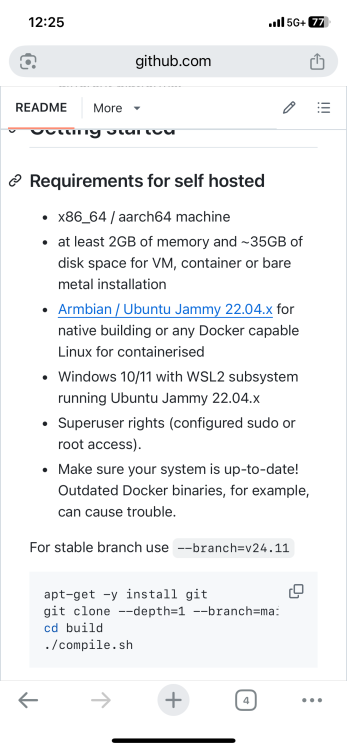-
Posts
477 -
Joined
-
Last visited
Content Type
Forums
Store
Crowdfunding
Applications
Events
Raffles
Community Map
Everything posted by Nick A
-
-
@svyatoslav are you using Ubuntu jammy? https://releases.ubuntu.com/jammy/
-
@svyatoslav are using an ethernet hub? if yes try using the first port or other ports. [ 7.956904] ahub_dam-snd-soc-dummy-dai: substream ahub_dam-snd-soc-dummy-dai has no playback, no capture [ 7.956931] sunxi-snd-mach soc:ahub_dam_mach: ASoC: can't create pcm ahub_dam-snd-soc-dummy-dai :-22 [ 7.957123] sunxi-snd-mach soc:ahub_dam_mach: probe with driver sunxi-snd-mach failed with error -22 Don't worry about this error sound should work. "aplay -l" will list the hardware devices. I have audiocodec and HDMI on my box. You can use pulse audio to switch the default sink.
-
You need a PC... it would probably take days to compile a build on a SBC.
-
@979101h I have the original X98H. I'll test the image again on my box. Edit: Just tested the server image on my box. I have no issues with Ethernet. I have all the same messages but your missing. end0:Link is up - 100Mbps/Full - flow control rx/tx Someone with a x96q had issues with ethernet. He got it working using sicxnull version. I think the difference was this. Try changing the u-boot dts and use 0 instead of 16. https://github.com/NickAlilovic/build/blob/v20250306/patch/u-boot/u-boot-h616/171-add-x98h-defconfig.patch +&mdio1 { + rmii_phy: ethernet-phy@0 { + compatible = "ethernet-phy-ieee802.3-c22"; + reg = <0>; + }; +}; git clone https://github.com/NickAlilovic/build.git --branch v20250306 cd build pico patch/u-boot/u-boot-h616/171-add-x98h-defconfig.patch ./compile.sh choose "Do not change kernel configuration" choose "Show CSC/WIP/EOS/TVB" choose "I understand and agree" choose "x98h" choose "edge" rest is up to you. Your image should be in output/images directory. sicxnull version https://github.com/sicXnull/armbian-build/blob/X96Q-5.1-DDR3/patch/u-boot/u-boot-sunxi/board_x96q-v5-1/arm64-sun50i-h313-add-x96-q-ddr3-v5.1-defconfig.patch
-
Try installing these yourself before you build.. the build system recommends Ubuntu Jammy 22.04.x sudo apt install bison libc6-dev make dpkg-dev gcc ccache dwarves flex imagemagick libbison-dev libelf-dev libfdt-dev libfile-fcntllock-perl libmpc-dev libfl-dev lz4 libncurses-dev libssl-dev libusb-1.0-0-dev ntpdate patchutils pkg-config pv arch-test swig uuid-dev zlib1g-dev file tree expect colorized-logs zip pigz pbzip2 lzop zstd aria2 axel parallel rdfind libpython3-dev libffi-dev libgnutls28-dev gcc-aarch64-linux-gnu libc6-amd64-cross busybox gcc-arm-linux-gnueabi gcc-or1k-elf
-
@svyatoslav are you using my latest build? git clone https://github.com/NickAlilovic/build.git --branch v20250306
-
@svyatoslav there’s android firmware but the Linux driver is old. Your dmesg doesn’t show any wifi info because there’s no driver. Unless you know how modify kernel drivers I would forget about it and use a usb wifi adapter.
-
@svyatoslav there’s a driver for the wifi chip but it only works on older kernels. You’ll need to port the code over to the latest kernel. https://github.com/paolosabatino/ssv6x5x/tree/master Click on the show csc/wib/eos/tvb button. You will see x98h and other h618/h616 boxes there.
-
@kvvvp try this sudo update-alternatives --set iptables /usr/sbin/iptables-legacy sudo update-alternatives --set ip6tables /usr/sbin/ip6tables-legacy
-
Need more debug info. Try running “sudo dockerd --debug”
-
@Rodrigo Campos have you tried my latest images? There’s a new patch for dram detection.
-
Here's the steps to create a secure boot image git clone https://github.com/NickAlilovic/build.git --branch v20250306 cd build pico patch/u-boot/u-boot-h616/153-add-tanix_tx6s_axp313_defconfig.patch You need to add this line to the bottom. "+CONFIG_SPL_IMAGE_TYPE_SUNXI_TOC0=y" and change "@@ -0,0 +1,37 @@" to @@ -0,0 +1,38 @@. or just overwrite the file with this one. diff --speed-large-files --no-dereference --minimal -Naur u-boot-sunxi-647b392bf20614006917d5fcd3390347a668eee5/configs/tanix_tx6s_axp313_defconfig u-boot-sunxi-647b392bf20614006917d5fcd3390347a668eee5/configs/tanix_tx6s_axp313_defconfig --- u-boot-sunxi-647b392bf20614006917d5fcd3390347a668eee5/configs/tanix_tx6s_axp313_defconfig 1970-01-01 01:00:00.000000000 +0100 +++ u-boot-sunxi-647b392bf20614006917d5fcd3390347a668eee5/configs/tanix_tx6s_axp313_defconfig 2023-04-08 11:53:13.408413187 +0200 @@ -0,0 +1,38 @@ +CONFIG_ARM=y +CONFIG_ARCH_SUNXI=y +CONFIG_DEFAULT_DEVICE_TREE="allwinner/sun50i-h616-tanix-tx6s-axp313" +CONFIG_SPL=y +CONFIG_SUNXI_DRAM_H616_DDR3_1333=y +CONFIG_DRAM_CLK=648 +CONFIG_DRAM_ODT_EN=y +CONFIG_DRAM_SUN50I_H616_UNKNOWN_FEATURE=y +CONFIG_DRAM_SUN50I_H616_BIT_DELAY_COMPENSATION=y +CONFIG_DRAM_SUN50I_H616_READ_CALIBRATION=y +CONFIG_DRAM_SUN50I_H616_DX_ODT=0x03030303 +CONFIG_DRAM_SUN50I_H616_DX_DRI=0x0e0e0e0e +CONFIG_DRAM_SUN50I_H616_CA_DRI=0x00001c12 +CONFIG_DRAM_SUN50I_H616_ODT_EN=0x00000001 +CONFIG_DRAM_SUN50I_H616_TPR0=0xc0000c05 +CONFIG_DRAM_SUN50I_H616_TPR2=0x00000000 +CONFIG_DRAM_SUN50I_H616_TPR10=0x2f0007 +CONFIG_DRAM_SUN50I_H616_TPR11=0xffffdddd +CONFIG_DRAM_SUN50I_H616_TPR12=0xfedf7557 +CONFIG_MACH_SUN50I_H616=y +CONFIG_R_I2C_ENABLE=y +CONFIG_SPL_I2C=y +CONFIG_SPL_I2C_SUPPORT=y +CONFIG_SPL_SYS_I2C_LEGACY=y +CONFIG_SYS_I2C_MVTWSI=y +CONFIG_SYS_I2C_SLAVE=0x7f +CONFIG_SYS_I2C_SPEED=100000 +CONFIG_PHY_REALTEK=y +CONFIG_SUN8I_EMAC=y +CONFIG_I2C3_ENABLE=y +CONFIG_AXP313_POWER=y +CONFIG_USB_EHCI_HCD=y +CONFIG_USB_OHCI_HCD=y +CONFIG_USB_MUSB_GADGET=y +CONFIG_SUPPORT_EMMC_BOOT=y +CONFIG_SYS_MMCSD_RAW_MODE_U_BOOT_SECTOR=0x40 +CONFIG_MMC_SUNXI_SLOT_EXTRA=2 +CONFIG_SPL_IMAGE_TYPE_SUNXI_TOC0=y pico patch/u-boot/u-boot-h616/secure-boot.patch create the secure boot patch. diff --git a/root_key.pem b/root_key.pem new file mode 100644 index 0000000000..892a10ef90 --- /dev/null +++ b/root_key.pem @@ -0,0 +1,28 @@ +-----BEGIN PRIVATE KEY----- +MIIEvgIBADANBgkqhkiG9w0BAQEFAASCBKgwggSkAgEAAoIBAQCWZ7G39E+RCi+9 +B48yiD4GxnfqNzvlXOxAd+GHQuKbgynXZd5pIuNHt3ewhZTHZkdHxuO9liqX9MmU +8OhiG+Skww2LzHPPi/eLeN4vCt/waXkjFrkblkhNzB3c6MejKdiz9sfw8oeOFX1S +teP/MJBoRaj6Hexj5g/oCspU+KFfv0cOBcWuq4vZwPJ6+U44IBi7EGleShGHNhBI +xQEyvNaDLWoDCPGLrjRM0DrIbUpzEntk9KJ0z+3Th8O/FtvlW21atolIVr5F96Pw +EEv3CDUHrY+IvK0z+IwNhnYo99kMPi5djB6vviz4In530JQ+OdPxhi4cQY3Yw9wx +Sm8EFaRRAgMBAAECggEAEaEcZ+k7VU8aGuBStNPa31zui9XHD8KlT4YtuXbJzHwi +kKSYXf7woISdAyQZNQkkREHICn4aRn7zDOHy/yLxWS2ivhbsITDxBlhXxLBT4OBg +ClCcyGLEXVgWTQE8+z9Jrwh3VaL76BfVPXdj/tKwroQxwwV0Yp5CEYsIPc75zVjW +Y2tppJL9XlTfKXTSo7FAxJmjkTC8QGPSHgMglR5FOfZ/D3Nj4KV4LV1gHCkICKUy +c2jklHISy8S6/pvgpWb50TKArEhbN6uAKQBNb74ZsChKJ9h9aof/vjH/8Ab1rwUJ +g91lpkR3mEefTjJTW1JOuoT49Y3lfWmkRVh75GiCsQKBgQDUo3uMcy9VdbbmY9Gt +2JuhbSvwR/dOHZJoXvtlNYVJ+1JvavExBy2u31cYsK/2SH/Upc8AXS6H02dXbnC3 +wjlUFi21Xi7/PCQM8TUz05km3+9qOkDYw53EBBBnCdjawBpDgcUSkoZGU+ltBzcR +sj0nsmI29DjwfYHXhofnlfI52QKBgQC1E2Q0hGfk3YUtfzTjDJCfd3gs6QYGQGeT +49jvnsbYsnz9vsK4Ao2skN8nBhSefDJR8h2X+7tRXEefQB2Hy/+9qoiuoVzPJGWD +IiHjeVJDoEqA2Q483UhZ+OPjUGFDTI7O/j1A1HkEBKswdJpKlGVygdoXYaieUAfz +Sb+dCYf7OQKBgQCWkE/aSnE4vQpOJl4BEABbFFdpYzvcpxnVJ3Qw3O3NTdS4Keww +wBl72o7sX6eo5vsE0oc5hcF90ZY6FWxg4XkAblfdNZxng+ku9NisIuct3KDFAgyK +sDCU7B/FJfbUJfQy2r91gCTtxVripZo7wI6G/kuHB/UNbIE04AB5XfZPOQKBgAGw +K5f9wAY3Nn2lGPYg8Nw7vegVSBQY155eWnBpd4sfpuCqvZ//jhiUxS/U865ClCmF +a1c2ZpmslZJbg6r3cOvwwhN2t6nKuhON5uj7AZRV0zv+Sg6xNXJ5So6c+jspZI9z +eVi4YmRyMrJh8+pMFeIKaeEb7PmE334aKuoo45apAoGBAKNp7ssXgU4Ma7cUr7+L +TKGBNVsMZyM3T2qsXJjFY1f90+lwp7TlNQGVMPOSOHxyINWkuLNgAgetlhavnc0S +0l+SbSaO6SfnHfQWBFPEJfol8V/Xa4rcVP7fGxQn4phYnk14N09xKIQa24Mi2Xa5 +9G0C2VOB8Yz6OWcQZELs0uFp +-----END PRIVATE KEY----- -- 2.34.1 ./compile.sh choose "Do not change kernel configuration" choose "Show CSC/WIP/EOS/TVB" choose "I understand and agree" choose "tanix-tx6s-axp313" choose "edge" rest is up to you. Your image should be in output/images directory.
-
The driver is old. It needs to be updated to work on the newer kernels. You can try compiling it and see if it works. I don’t have a box with this wifi chip so I can’t help you.
-
I’m wondering if it’s your ram settings. If you extract your original android dts. You might find it there.
-
https://github.com/NickAlilovic/build/commit/330b0609efe49a8cf339a0a8aff9be65b910641e
-
Try compiling this version from https://github.com/sicXnull/armbian-build/tree/X96Q-TVBOX-LPDDR3 git clone https://github.com/sicXnull/armbian-build.git --branch=X96Q-TVBOX-LPDDR3 cd armbian-build ./compile.sh choose "Show CSC/WIP/EOS/TVB" Select "x96q-v1-3"
-
Try my latest images maybe they will work for you https://github.com/NickAlilovic/build/releases/tag/20250306
-
I just saw your wifi chip in the picture. Unfortunately, this chip only has drivers for older kernel versions. You’ll need to use a usb wifi device or Ethernet.
-
@Robert Roig Santamaria this is not an android forum. I can only show you how to install linux on your box. If you want to run linux on your box then write the transpeed image onto a SDcard. I use this software to write images. https://etcher.balena.io/ and you can find my custom made images here. https://github.com/NickAlilovic/build/releases/tag/20250306
-
That odd are you sure you didn't mix up the images? I think Tanix, tx6 image can boot on Vontar.
-
-
@Felps you need to install it on emmc using armbian-config.
-
Try this Armbian image https://github.com/NickAlilovic/build/releases/download/20250306/Armbian-unofficial_25.05.0-trunk_X96q-lpddr3-v1-3_bookworm_edge_6.12.11_xfce_desktop.img.xz
-
@Felps which image are you using exactly?



